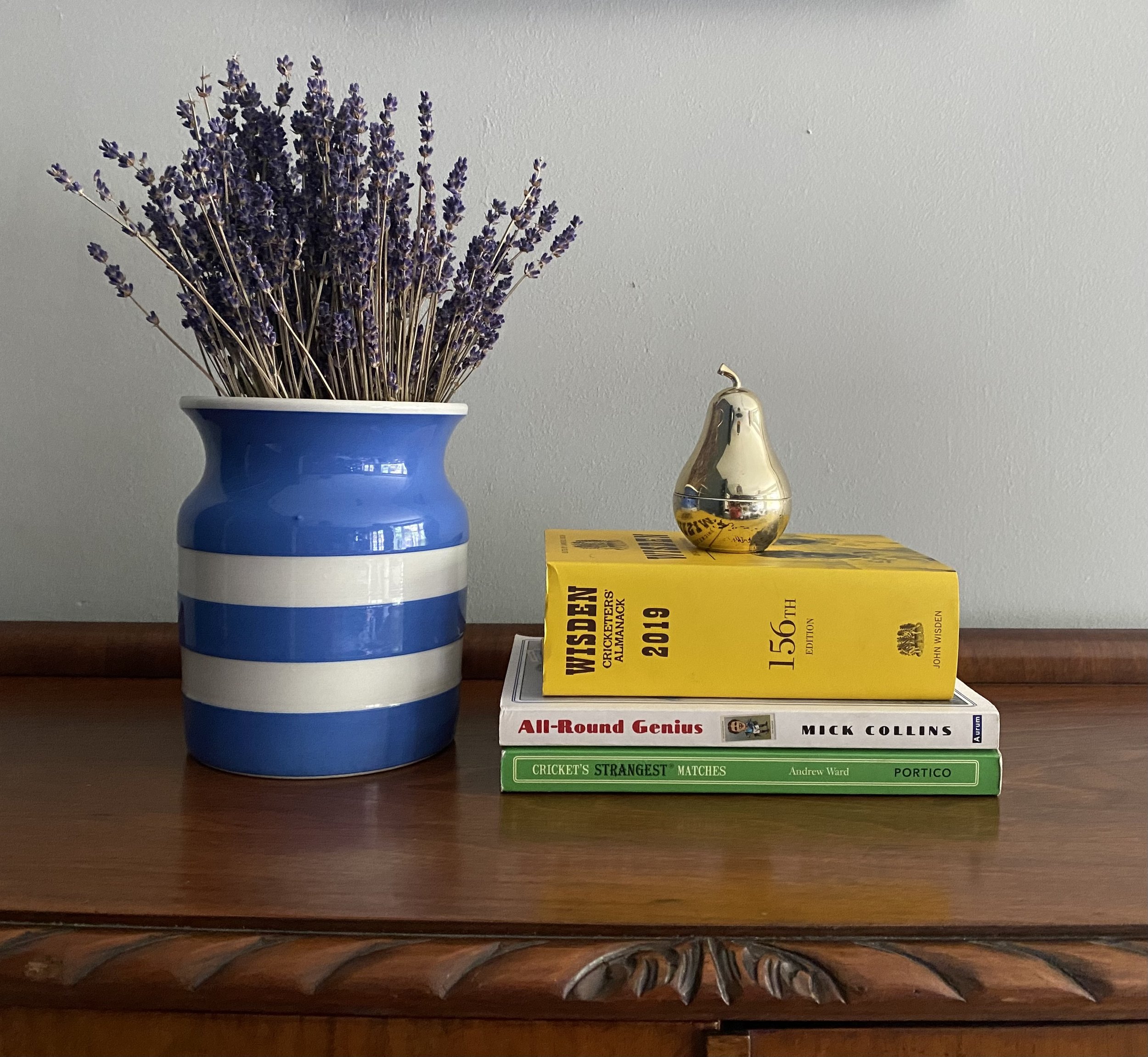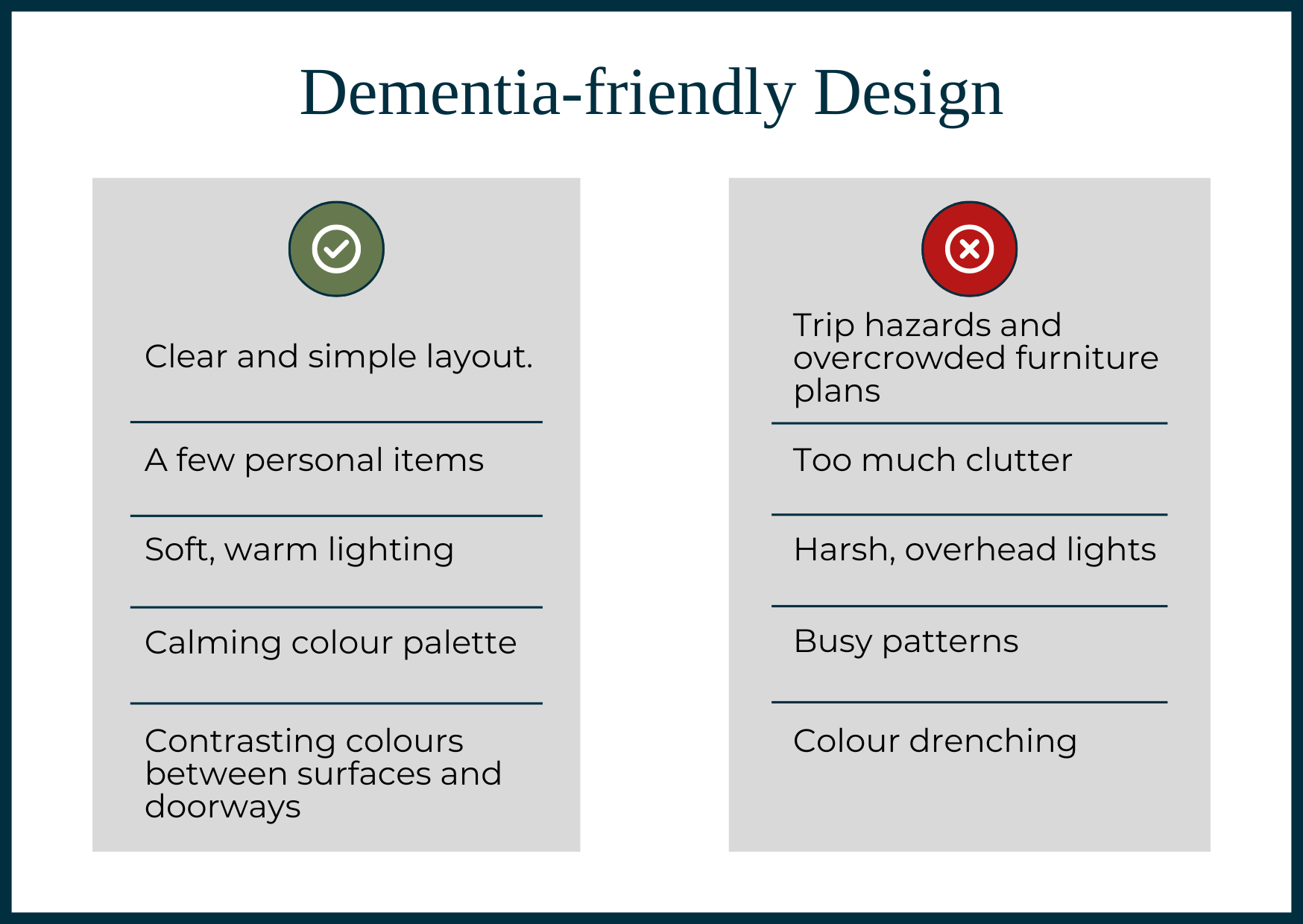Inclusive Spaces: A Guide to Dementia-Friendly Interior Design
Living with Dementia is challenging, for the individuals diagnosed, as well as their friends and family. I have experienced the effects of this debilitating condition professionally, during my nursing career, and personally, within my own family, and now as an interior designer, with a passion for inclusive and accessible interiors, I use my knowledge and experience of dementia to create and advocate for dementia-friendly spaces.
Creating a safe and accessible home environment for dementia sufferers, helps to promote wellbeing, independence, and safety, as well as providing peace of mind and reassurance, for their relatives and carers. In this blog post I will provide practical tips for creating interior spaces for people living with dementia, so that their home can become a safe and supportive space, that can adapt as their needs change, and the disease progresses.
What is Dementia?
Dementia is a blanket term for a group of diseases that affect memory, cognitive ability, and social skills. Alzheimer's disease is the most common form of dementia, but there are many others, with different groups of symptoms and patterns of progression. Individuals with dementia may appear to be confused, disoriented and anxious, particularly in unfamiliar surroundings. However, it's important to remember that each person's experience of dementia is unique, and we can't assume that everyone with a dementia diagnosis goes through it in exactly the same way.
How Can We Create Dementia-Friendly Spaces?
A dementia-friendly home can have a huge impact on the quality of life and wellbeing of people living with the condition. A thoughtfully designed space can help to reduce confusion and promote safe, independent living. As with any interiors project, it's vital to recognise and appreciate the individuality of each person, so that their surroundings can be tailored to create a space that feels safe, comfortable and supportive. Here are six key elements for consideration when designing a dementia-friendly home:
1. Safety
Safety should be a top priority for any design project. When designing for dementia, we want individuals to be able to move around their home safely, so it’s important to create a layout that allows for clear, unobstructed paths between and around rooms, allowing plenty of space for mobility aids, if they are required.
If space permits, a strategically placed chair, to give the option of sitting, for tasks such as dressing and food preparation, or for resting during longer journeys through the home, can also help to minimise the risk of falls.
Remove trip hazards such as loose rugs and uneven or slippery flooring, and consider the placement of electrical sockets, so that they can be easily accessed, and cables won’t need to be trailed across the floor to be plugged in. Ask an electrician to move or install additional sockets if needed.
Including handrails to assist with balance, and securing heavy items, such as cabinets and bookshelves to the walls, so they cannot be pulled over, helps to create a safer environment for moving through the home.
2. Simple Layout
Simplicity is key. Reducing clutter, minimising the number of furnishings, and avoiding busy patterns, can have a calming effect, and helps individuals with dementia to process and understand visual information from their surroundings.
Using simple colour-coded signs, and contrasting floor materials, can also help people to understand their surroundings and find their way around.
A simple layout, free from clutter can help safe movement around the home. (AI generated image)
3. Familiarity
I always advocate incorporating familiar elements into any design scheme – it’s these treasured items, that fill us with joy and memories, that make a house a home!
When designing for dementia, its particularly helpful to include personal belongings, photographs, and familiar items, as they can assist with memory, and help individuals to feel a connection to their surroundings.
4. Lighting
There are several ways in which lighting can help to create a dementia-friendly home.
The natural deterioration of our eyesight as we age means that many people with dementia will have some degree of visual impairment. Adequate lighting is essential to ensure that rooms are well-illuminated, and easy to move around safely.
Some individuals with dementia experience “sundowning”, which causes increased confusion and restlessness, during late afternoon and evenings. Sundowning is thought to be connected to the internal 24-hour body clock, or circadian rhythm, and can be exacerbated by tiredness and sensory overload.
When designing a lighting scheme for somebody who experiences sundowning its important to maximise exposure to natural light during the day, and block out light at night, as this helps to regulate the internal “body-clock”. Consider blackout blinds, shutters, or lined curtains, that can be easily adjusted to control light.
Choose soft, diffused lighting with warm coloured bulbs and dimmer switches, which can be used to dim the lights gradually throughout the evening to signal night-time and help to create a relaxing atmosphere before bed.
Night-time wandering can be an issue with dementia sufferers, as well as night-time bathroom visits, which are more common as we age, so using nightlights or low-level lighting in bedrooms and hallways can help to reduce the risk of falls during darker hours.
People with dementia can have difficulty distinguishing between shadows and real-life objects or people, and shadows can trigger hallucinations, confusion, and fear. Opting for soft, diffused lighting, rather than fluorescent bulbs and harsh overhead lights, and avoiding placing objects where shadows may be cast, can help to minimise the disorienting and confusing effects of shadows.
5. Sensory Stimulation
There is a deep connection between our memories and our senses, so creating a multi-sensory environment, that gently engages the senses, can help individuals with dementia to recall positive memories and relax.
Incorporating soothing colours and textures, plants, and favourite scents, alongside personal objects, photographs, and music can help to stimulate the senses and enhance comfort and wellbeing.
Care should be taken not to overwhelm the senses, as people with dementia can become agitated and confused in sensory overloaded environments.
Loud noises, and poor acoustics, may lead to difficulty filtering out background sounds and understanding speech.
Busy patterns on wallpaper, upholstery, or flooring may cause visual confusion and make it difficult to distinguish between objects or surfaces.
Highly reflective surfaces including mirrors, glossy tiles and worktops, and polished floors, can create glare, and reflections dementia sufferers do not recognise, or mistake for another person. High gloss finishes can also appear to be wet, potentially triggering confusion and fear.
Colour schemes that lack contrast between surfaces such as walls, floors, and furniture, can make it difficult for individuals with dementia to differentiate different elements in a room, leading to problems navigating the space. Sudden changes in flooring materials or textures can also create visual confusion and increase the risk of trips and falls.
Rooms that are cluttered with too many furnishings and decorations can create visual overload and make it difficult for individuals with dementia to focus or navigate their surroundings.
Including treasured, personal items and favourite scents can engage the senses and help people with dementia feel a connection to their surroundings.
6. Adaptability
As the needs of individuals with dementia deteriorate over time, it’s important to design spaces that can adapt to changing abilities and preferences. Choose furniture and fixtures that are adjustable, and easy to reconfigure, such as height adjustable tables, recliner chairs and profiling beds. Opt for room layouts that can be easily adapted to allow for additional mobility aids, or assistance from carers, and consider use of technology, that can be used to control items throughout the home, such as lights, heating, appliances, and doorbells, as well as assisting people to remember things and call for help if required.
Dementia profoundly affects how individuals perceive and interact with their surroundings, and designing interior spaces for people with dementia requires a thoughtful and compassionate approach, that prioritises safety, simplicity, adaptability, comfort, and sensory stimulation. By implementing dementia-friendly design, we can create environments that respect individuality, minimise confusion, and support independence and dignity, enhancing quality of life, and promoting overall wellbeing, for those with dementia, and their loved ones.
Kim Heslip is an interior designer and the founder and owner of Nest and Flourish Interiors. Kim is an advocate for diversity and inclusion and is passionate about the enormous impact our surroundings have on our health and wellbeing.
Kim has a wealth of knowledge around accessible and inclusive design and believes beautiful interiors are for everyone. She helps people, throughout the Yorkshire region, who have health and accessibility requirements, to redesign interior spaces, accommodating their needs, without compromising on style.
Contact Kim to find out how she can help you to make life-enhancing improvements to your interior spaces that embrace your individuality and support all of your needs.




